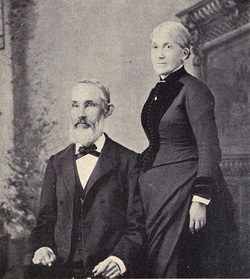BINGHAM II, HIRAM

(16 August 1831, Honolulu, HI-25 October 1908, Baltimore, MD). Education: B.A., Yale College, 1853; studied at Andover Seminary, 1855-56. Career: Principal, Northampton High School, 1853-54; private tutor, Europe, 1854-55; missionary and translator, Gilbert Islands and Hawaii, 1856-1908, with intermittent visits to the United States.
The son of a great linguist and missionary, Hiram Bingham carried on the Polynesian work of his father in the Gilbert Islands. Bingham was born at a mission station in Hawaii in 1831 and received his early education at a mission school in Honolulu. After attending college and seminary in New England, he embarked on the brig Morning Star in 1856 to begin his missionary career. His father, Hiram Bingham* , had been married just twelve days after his ordination. The younger Bingham married only nine days after ordination, and like his father, set sail less than two weeks later. The church, the family, and the mission could easily have been seen as a seamless web by these later-day pilgrims.
Bingham spent seven years in the Gilbert Islands, struggling against disease, hunger, and hostile merchants. During that time he made few converts, about fifty in all, but learned the language and began translating the Bible into Gilbertese. Due to ill health, he was forced to return to Honolulu in 1864. Except for occasional visits to the United States and another short stay in the Gilberts (1873-75), Bingham spent the remainder of his life in Hawaii. There he devoted himself to an epic task, the translation of the entire Bible into Gilbertese. With the help of a Gilbert Islander, Moses Kaure, who had followed him to Hawaii, he completed the Bible in 1890. Bingham also wrote a Gilbertese hymn book, commentaries on the gospels, and a Gilbertese-English dictionary. His wife published a book of Bible stories in Gilbertese.
As missionaries and linguists the Binghams, father and son, and their wives, carried on a tradition that can be traced deep into the Congregational past, when John Eliot walked a few miles from his home parish of Roxbury, Massachusetts, to preach to the Indians.
Bibliography
A: Te boki n anene [Gilbertese hymnal] (Honolulu, 1863); Te boki n reirei [Gilbertese language primer] (Honolulu, 1865); Gilbert Islands Bible Dictionary (Honolulu, 1895); Gilbertese-English Dictionary (Boston, 1908).
B: DAB 2, 276-77.
The son of a great linguist and missionary, Hiram Bingham carried on the Polynesian work of his father in the Gilbert Islands. Bingham was born at a mission station in Hawaii in 1831 and received his early education at a mission school in Honolulu. After attending college and seminary in New England, he embarked on the brig Morning Star in 1856 to begin his missionary career. His father, Hiram Bingham* , had been married just twelve days after his ordination. The younger Bingham married only nine days after ordination, and like his father, set sail less than two weeks later. The church, the family, and the mission could easily have been seen as a seamless web by these later-day pilgrims.
Bingham spent seven years in the Gilbert Islands, struggling against disease, hunger, and hostile merchants. During that time he made few converts, about fifty in all, but learned the language and began translating the Bible into Gilbertese. Due to ill health, he was forced to return to Honolulu in 1864. Except for occasional visits to the United States and another short stay in the Gilberts (1873-75), Bingham spent the remainder of his life in Hawaii. There he devoted himself to an epic task, the translation of the entire Bible into Gilbertese. With the help of a Gilbert Islander, Moses Kaure, who had followed him to Hawaii, he completed the Bible in 1890. Bingham also wrote a Gilbertese hymn book, commentaries on the gospels, and a Gilbertese-English dictionary. His wife published a book of Bible stories in Gilbertese.
As missionaries and linguists the Binghams, father and son, and their wives, carried on a tradition that can be traced deep into the Congregational past, when John Eliot walked a few miles from his home parish of Roxbury, Massachusetts, to preach to the Indians.
Bibliography
A: Te boki n anene [Gilbertese hymnal] (Honolulu, 1863); Te boki n reirei [Gilbertese language primer] (Honolulu, 1865); Gilbert Islands Bible Dictionary (Honolulu, 1895); Gilbertese-English Dictionary (Boston, 1908).
B: DAB 2, 276-77.
